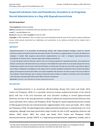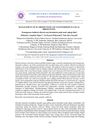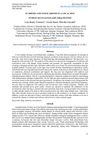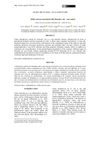Abstracts
October 2020
in “
Veterinary Dermatology
”
demodicosis sarolaner glucocorticoid therapy Pseudomonas aeruginosa otitis florfenicol ophytrium seboliance atopic dermatitis superficial bacterial folliculitis chlorhexidine canine cathelicidin superficial pyoderma ciclosporin A lokivetmab hypoallergenic diet insect protein-based diet otitis feline leishmaniasis cat fleas tigilanol tiglate sterile granulomatous pyogranulomatous dermatitis omega-3 rich essential fatty acids junctional epidermolysis bullosa prick test-based restrictive diet adverse food reactions extensively hydrolysed protein-based food Demodex Simparica steroid therapy Pseudomonas ear infection antibiotic ophytirium sebaceous balance allergic dermatitis bacterial skin infection antiseptic natural antibiotic skin infection Atopica Cytopoint allergy diet bug protein diet ear infection leishmaniasis flea treatment tumor treatment omega-3 fatty acids genetic skin disorder allergy test diet food allergy hydrolyzed protein diet
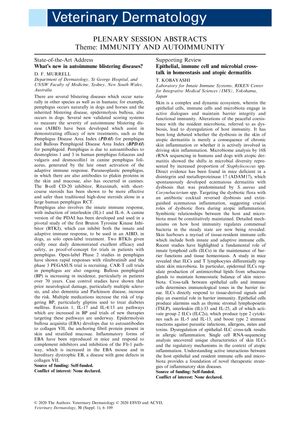
TLDR New treatments and diagnostic methods for various animal skin conditions showed promising results.
The document presents findings from a veterinary dermatology conference, highlighting various studies and case reports on animal skin conditions and treatments. Key points include the development of a quantitative PCR technique for measuring treatment response in dogs with demodicosis, the effectiveness of oral sarolaner in a toy poodle with demodicosis, and the use of partial traction/avulsion with glucocorticoid therapy for feline aural inflammatory polyps. A prospective study showed improvement in dogs with Pseudomonas aeruginosa otitis using an antibacterial approach without glucocorticoids. Other studies reported on the antibacterial activity of florfenicol, the efficacy of a shampoo and mousse containing ophytrium and seboliance for dogs with scaling disorders, and the high prevalence of mite sensitization in dogs with atopic dermatitis in southern Brazil. Additionally, research on canine superficial bacterial folliculitis, the antimicrobial activity of chlorhexidine combined with canine cathelicidin, and the use of natural formulations for treating canine superficial pyoderma were discussed. The document also covered the effectiveness of a new oral liquid ciclosporin A for canine atopic dermatitis, the control of pruritus with lokivetmab, the hypoallergenic properties of an insect protein-based diet, and various ear treatments for otitis in animals. Lastly, it included studies on the treatment of feline leishmaniasis, the susceptibility of cat fleas to different treatments, the pathology of buffalo fly lesions in cattle, and the use of tigilanol tiglate for treating tumors in dogs. The document also mentioned a case of sterile granulomatous pyogranulomatous dermatitis in a cat treated with omega-3 rich essential fatty acids and a genetic cause for junctional epidermolysis bullosa in a cat. A prick test-based restrictive diet was shown to improve clinical signs of food allergies in dogs, and wearable activity monitors provided objective data on clinical signs in dogs with adverse food reactions. An extensively hydrolysed protein-based food was effective for suspected cutaneous Adverse Food Reactions in cats.
